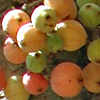False Sycomore Fig is a large tree with a round crown, of tropical origin. It is one of the prominent trees in the southern coastal plain. It grows in Israel mainly in places with shallow underground water. Some of the trees are large and impressive and are well-known. They are often mentioned in the literature on the nature, geography and history of the settlement in Israel. The species belongs to the same genus as the fig. It originates from East Africa, where its natural pollinator lives. The tree there produces numerous seeds and reproduces regularly with the help of its pollinator. There are obligatory (each party necessarily needs the other), mutual relations between the syconium and its pollinator. The pollinator is not present in Israel, and the tree does not produce seeds at all. It reproduces only by cuttings. It appears that every False Sycomore Fig in Israel was planted by man as a cutting.
Ficus sycomorus was first brought to Israel by man during the dawn of history, 6,500 years ago, and perhaps even 10,000 years ago. The tree was apparently planted in Israel for its shade as well as for its fruit. The fruit is plentiful, edible, but not regarded of high quality. The wood was also used for construction (mainly roofs) and for heating. In ancient Egypt the wood was also used for coffins. In Israel, doors of an ancient synagogue were found that were made from Ficus sycomorus wood. About a tenth of all wood pieces that were found at Masada from the Roman period were made of Ficus sycomorus wood.
In its warm homeland it is an evergreen tree. In Israel it is sometimes deciduous and sometimes not, according to the climate in the particular site of each tree. It does not grow at all in really cold places (mountains), as mentioned already by Our Sages of Blessed Memory (see the Heritage section).
The trunk thickens rapidly, creating a single, picturesque, gnarled and very impressive trunk. At a certain height the tree becomes branched, and creates a round mushroom-shaped crown. The trunk thickens on its lower part near the root system, close to the soil surface.
The leaf is rigid, entire, ovate, cuneate. Its base is somewhat cordate. The leaf is fragrant, somewhat hirsute, shiny on the lower side. It oozes a milky juice when damaged.
Ficus sycomorus blooms in the several times during the summer. The inflorescence is a syconium typical of the large genus Ficus (see also the Fig): the flowers sit inside a concave hollow round receptacle. All the flowers of a syconium are of one sex, i.e. there are male and female syconia. In the biblical literature the syconium is also called gamasia.
The syconia are clustered in racemes on the trunk and on large branches, a common feature of tropical trees, unlike most of the other trees in Israel.
As mentioned, the flowers are not fertilized in Israel, and the tree does not produce seeds. However, at a certain stage the syconium can be eaten. The tree produces a multitude of syconia, generously supplies food, and “dirties” its surrounding. The seedless fruits are unfertilized (parthenocarpic). Many syconia develop of their own at a second stage into juicy edible fruits. Others can be “encouraged” to turn into edible fruits by puncturing the syconium to cause it to ripen. Larger parthenocarpic fruits develop on the trees at the end of the summer and early autumn. They contain parasitic wasps that make the syconia inedible.
This tree is in danger of extinction in Israel since it grows in the coastal plain, which is under accelerated development, and since it does not reproduce by itself. Numerous public campains have taken place to prevent the felling of certain Ficus sycomorus trees.
The genus Ficus is a large genus. It includes 1000 species, including the fig, and many species of giant ornamental trees.
This tree, like other trees of tropical origin, does not produce annual rings and it is therefore impossible to accurately determine the age of ancient trees of this species. There are different estimates of the ages of the trees currently found in Israel. One of the famous individuals is found in a small public park on Mintz Street in Netanya, near the ancient fortress there. The immense tree is presented in a photograph from 2008. This individual was drawn in a book by the traveler Wilson who visited the Land of Israel in the second half of the 19th century. Already in that drawing the tree appears large and very ancient. Wilson recounted that he met watermelon merchants from the area resting in the shade of this tree.
Written by Mike Livne






